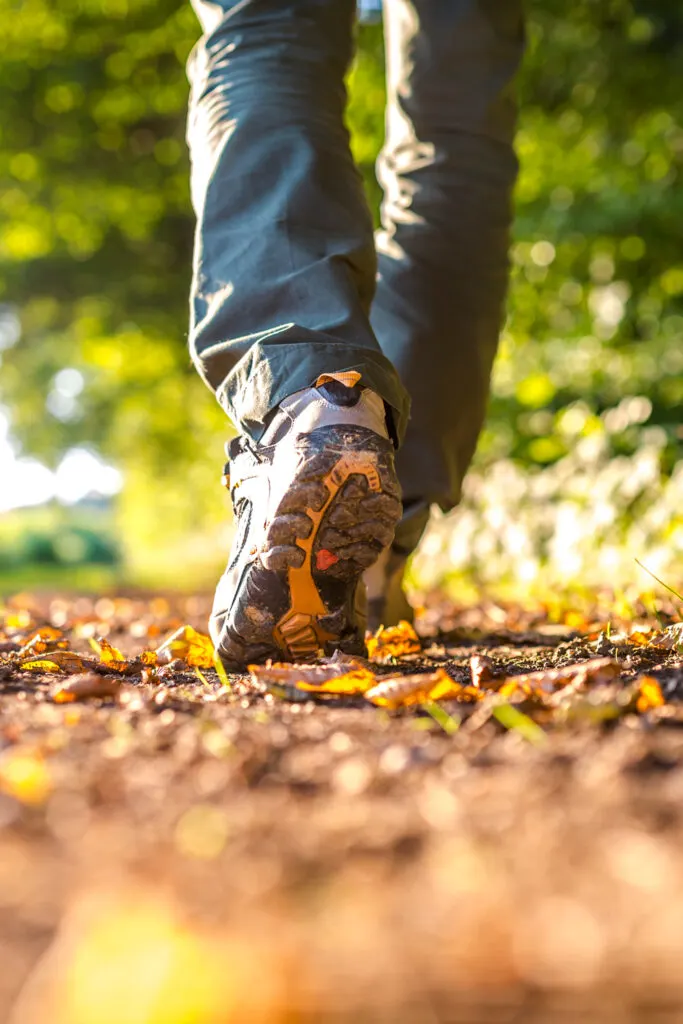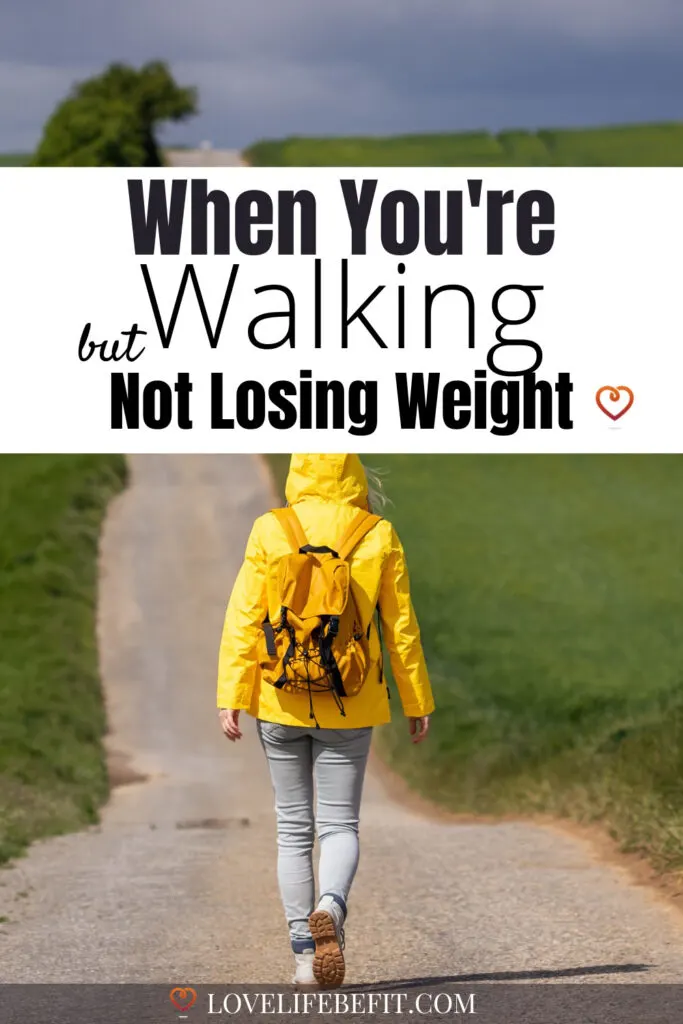You’re fired up and you’ve just started your new walking for weight loss regime. This time you’re doing everything right and sticking to your fitness plan. You’re feeling terrific but there’s just one problem. It’s a big problem – you’re not losing weight walking.
Before you completely despair and abandon your weight loss goals, read on to find out the causes of your failed weight loss or even weight gain – and what you can do to improve your weight loss progress.

Gaining Weight From Walking
It sucks, but if you’ve just started your walking for weight loss plan, there’s a good chance you will gain weight in the first few weeks.
Your body is responding to the shock of a new exercise regime. Exercising causes small micro tears and inflammation in your muscle fibers. The inflammation causes water retention.
But it’s temporary. As your body adjusts to the new regime, your body will begin to shed the water weight, and you’ll start to see an improvement on the scale. So don’t give up!
Increased Muscle Glycogen
When you exercise one of your main energy sources is glycogen. It’s a form of carbohydrate stored in your liver and muscles. Glycogen is stored in water and has to bind with water to provide energy.
The stored water can make your muscles look bigger, but it’s all extra weight. Another reason why the number on the scale may go up when you start to exercise.
Eventually, your muscles will adjust to walking, using less glycogen for your new walking regime and you’ll lose that initial water weight.
Walking Makes You Hungry
When you’re trying to lose weight, being hungry from walking sounds like something that’s going to sabotage your weight loss plans. But before you give up or decide that walking isn’t a good way to lose weight, let’s explore hunger a little further.
In a privileged world with fast food on tap, most people are never hungry. We eat for so many reasons – because we love the taste of food, for social reasons, and out of boredom.
Most of us have forgotten how wonderful it is to eat when we’re hungry – how wonderful everything tastes and how good it feels to eat.
Eating when you’re hungry is nothing to feel guilty about. You just need to learn when to stop. Listen to your body’s signals.
After a walk, eat a small meal of fresh food. Include whole grains, vegetables, and lean protein. Drink some water and make sure you’re fully rehydrated. Pause eating for 5 to 10 minutes and tune into what your body’s telling you.
If you’re still hungry, eat some more. But if you’re not hungry – stop eating!
Walking to lose weight is about building a calorie deficit so that you burn more calories than you consume.
For many people, walking needs to happen alongside learning better eating habits – so that you’re eating fewer calories from unhealthy high fat, high-sugar foods.
When you’re hungry, reach for the nutritious foods your body needs – the healthy food that will fuel your next walking session instead of adding inches to your waistline.

Walk Regularly To Lose Weight
There are no shortcuts to weight loss. I doubt you gained body weight overnight, so why do so many people expect to lose weight quickly?
We live in an impatient society that thrives on instant gratification. Everyone wants quick results. The diet industry makes billions every year selling quick-fix solutions that never work.
Losing weight from walking isn’t a quick fix. It’s a slow journey where you take small steps toward permanent weight loss. To keep the weight off long term you have to put in the time by walking regularly.
Enjoy your weight loss journey, and feel fitter and stronger from regular physical activity. Your weight loss efforts are worth it.
Be patient and follow a walking for weight loss plan. Walking has so many health benefits but to make big improvements to your overall health you do need to walk at least 5 times a week.
Set aside time in your schedule to walk every day and make it a priority. Your body will thank you for it.
Related post: How To Start A Walking Program For Beginners
Eating Too Many Calories
It’s tough, but following a walking plan isn’t a green light to eat everything in sight. If you want to lose weight, you need to eat a balanced diet of healthy foods and keep your calorie intake below your daily energy expenditure.
The number of calories you eat needs to be less than the number of calories you burn from walking and daily activities.
Eat better
There’s a saying, you can’t outrun a bad diet and the same applies to walking. The best way to lose weight from walking is to combine walking with eating better.
Start making small improvements to your diet. Nothing too drastic – it could be something as small as drinking water instead of sugary drinks. Keep this up until it becomes a regular habit – you’re reaching for water to drink without even thinking about it.
Then add in another small change – swap your cookies for fresh fruit!
Keep slowly adding in little changes to your diet until eating better healthy food becomes second nature.
Related post: Is Diet More Important Than Exercise?
Not Walking Fast Enough
Walking for weight loss isn’t a casual stroll. If you’re not losing weight, it could be because you’re not walking fast enough.
You need to walk at a brisk pace. That should be at least 3 miles per hour – but if you’re new to exercise and you’re carrying a lot of excess weight, it could be slower.
Walk at a brisk pace
A brisk pace is where you can still walk as you talk, but your heart rate is elevated and you’re working to maintain your pace. This sustained exercise is how you’ll burn fat and increase your calorie burn.
Think of walking as aerobic exercise instead of a leisure activity. With sedentary lifestyles, most people walk really slowly. Brisk walking is hard work! Your muscles will feel it. But it’s a great way to protect against heart disease and reduce blood pressure. Walking will benefit weight loss and so much more…
Related post: How To Get Results: Walking For Weight Loss
Muscle Gain
Muscle mass is denser than body fat. When you’re losing fat and replacing it with stronger muscles from walking, the outcome can be weight gain.
This makes the scales can be an unreliable indicator when you’re trying to lose weight by walking. Get out a tape measure and check measurements for your waist, hip and butt – if you’re losing inches, you’re still burning fat.

Weight Loss Plateau
Don’t panic. At some stage, most people will hit a weight loss plateau. You may just go one or two weeks without losing weight then your weight loss will suddenly pick up again… or you could get stuck… failing to burn that last bit of unwanted body fat.
Increase intensity
In the long term, your body adapts to regular physical activity and becomes more efficient at exercising. To get the same calorie burn as you get fitter, you need to up the intensity.
Try walking faster. Power walking is a great way to increase intensity and torch calories. Power walk for twenty minutes every day and you’ll be burning through more calories than a casual stroll!
Related post: Calories Burned Walking Calculator
Walk uphills
Walk uphills when you can. Walking uphill requires more effort than walking on a flat surface, meaning your body has to work harder and will burn more calories.
Related post: How Many Calories Do You Burn Walking Uphill
Add walking intervals
Alternatively, you can add intervals to your walking workouts. Interval training alternates bursts of higher-intensity activity with slower periods of recovery. You’ll burn fat and improve fitness with short bursts of power walking at high intensity.
Vary your route
If you’re failing to lose weight, try varying your route. Alternating routes will help you vary the intensity of your workouts and help to keep your walks fresh and interesting.
Short walks
It’s a good idea to wear your walking shoes or trainers throughout the day and take up every opportunity for short walks. Need something from the shops – walk there. Add a short walk in your lunch break – or walk to the post box.
Those extra short walks add up and will have a positive impact on your weight loss efforts. Look out for opportunities to increase the number of steps you walk every day.
Related post: How Much Walking For Weight Loss (How Many Miles Does It Take)
Add Strength Training
Maximize fat loss by adding in some strength and resistance training. When you lose weight without exercising, you’re in danger of losing muscles. Muscles drive your metabolism – so the result isn’t just a weaker body but a slower metabolism.
Walking will help you maintain or even increase your muscle mass as you lose weight but you can give your metabolism an extra boost by adding in strength training.
These bodyweight exercises will aid your weight loss journey and have the added benefit of strengthening your leg muscles to help you stay injury-free.
Thoughts From Love Life Be Fit
Walking is one of the best forms of exercise, especially when you have a lot of weight to lose and you haven’t exercised in years, But to get better results you do need to walk regularly and combine your walking routine with a healthy diet.
Be patient – you’ll soon see your commitment to walking for weight loss pay off as your fitness level improves and you lose those extra pounds!
